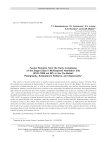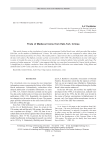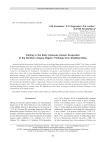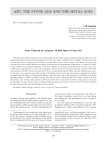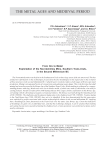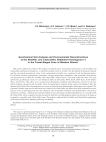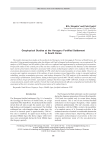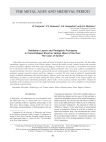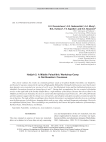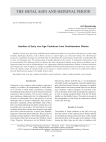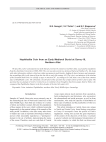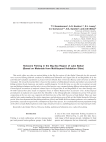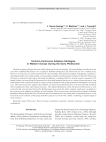Статьи журнала - Archaeology, Ethnology & Anthropology of Eurasia
Все статьи: 351
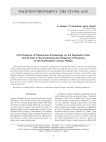
Статья научная
The northeastern Iranian Plateau is considered a leading region in Paleolithic studies. The history of Paleolithic research in this region dates back to the mid-20th century. However, unlike the western and, to some extent, the central part of the Iranian Plateau, only a handful of sites have been identifi ed in the northeastern part. Field studies conducted on the Neyshabur plain have provided some of the only Paleolithic evidence at four locations in the foothills of the Binalud Mountains: Dar Behesht, Mushan Tappeh, Ali Abad, and Qezel Tappeh. Our research aims to assess this evidence, provide a revised typology of Pleistocene artifacts from the Neyshabur plain, and also study the role of these and other fi nds in the area and analyze their signifi cance in terms of the dispersal of Pleistocene hominin populations. We propose two main corridors on the northeastern Iranian Plateau assumed to have been infl uential in the dispersal of human ancestors.
Бесплатно
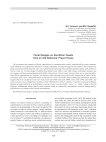
Floral designs on sacrificial towels from an old believers' Prayer house
Статья
We reconstruct the semantics of fl oral compositions on commemorative towels, embroidered by women, members of the Old Believers Bespopovtsy (priestless worship community rejecting marriage) in Novosibirsk. The original vine motif, associated with the funerary cult, was transformed by replacing vines with more familiar motifs, such as fl owers, berries, buds, etc. Certain designs resemble those found in late 19th to early 20th century embroidery manuals and on wrappers of cheap soap manufactured by Rallet, Brocard, etc. In most cases, however, there are no exact parallels. Some fl oral compositions are original: for instance, those showing vases with scrolls reminiscent of Jesus Christ’s monogram, and “vases” turned into letters on Our Savior’s icons. The results of the technological and stylistic analyses suggest that most sacrifi cial towels were made in the late 1800s and early 1900s, some in the 1940s and 1950s, and some may have been manufactured in places of the Old Believers’ former residence in northern and central Russia. Designs arranged in friezes or central fi gures, such as crosses, cruciate motifs, “vases”, or “vaults”, allude to the Old Believers’ fundamental values. Ritual towels evidence motifs on commercial embroideries creatively transformed by Old Believers according to their beliefs and traditions.
Бесплатно
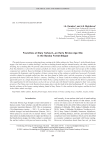
Foundries at Stary Tartas-5-an early bronze age site in the Baraba forest-steppe
Статья
This study focuses on areas evidencing bronze casting at the Odino culture site, Stary Tartas-5, in the Baraba foreststeppe. One such area is within dwelling 1 and has a smelting hearth and pits situated nearby; the other, outside the dwelling, has a smelting kiln. We provide characteristics of these areas and their archaeological context. Each artifact from the foundries is described in detail, parallels are listed, and results of binocular microscopy of the molding compound are outlined. Based on fi ndings of thermogravimetric studies, we assess the functions of technical pottery represented by fragments, and the number of times various items of the casting set could have been used. Previously, crucibles shaped as straight-walled jars have not been found at Odino sites, with the exception of a single intact specimen from burial 286 at the Tartas-1 cemetery. Dwelling 1 at Tartas-5 and the workshop associated with it were apparently parts of a single household. The Odino bronze casting tradition was retained by the Krotovo population, who supplemented it with innovations, such as the use of oval cups with thicker bottoms adapted to their own casting practices. The Odino sites in the Baraba forest-steppe date to the fi rst half of the third millennium BC. It is concluded that the evidence of the bronze casting industry found at Stary Tartas-5 is the earliest in that region, and that its level in the Odino culture was high.
Бесплатно
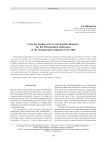
Статья
Serbian fi gured gingerbreads owned by the Russian Museum of Ethnography are described, the history of the collection is provided, and its cultural meaning is evaluated. Ethnographic parallels are analyzed, and archaic examples are cited. The custom of baking gingerbread results from the commercialization of the agricultural tradition of baking ritual bread. In terms of cultural anthropology, the question may be raised whether the replacement of destroyed originals by plaster replicas preserves the information potential and ethnographic value of the collection. Its interpretation is relevant to national identity in new Balkan nations such as Slovenia, Croatia, and Serbia. Another problem is if and how a craft shared by several peoples can be an ethnic marker. In terms of ethnographic museology in the globalizing world, the prospects of acquiring recent collections are discussed. The role of such collections in constructing new national identities may be considerable.
Бесплатно
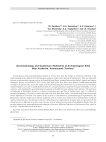
Geomorphology and quaternary sediments at archaeological sites near Anzhevka, Krasnoyarsk territory
Статья
Бесплатно
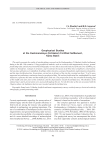
Geophysical studies at the Kushmanskoye (Uchkakar) fortified settlement, Kama basin
Статья
Бесплатно
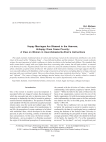
Статья научная
This study examines traditional ideas of women and marriage, based on the instructions attributed to one of the rulers of the epoch of the “Religious Kings”—Usun-Debeskertu-Khan, and his ministers. The focus is made on female virtues, the most important of which is adherence to duties in relation to the husband and children. The standards that noble women had to comply with were higher than those concerning other women, but still quite realistic, as attested to by historical records. Negative female traits were said to be caused by untamed emotions, which cause one to forget about commonly accepted norms of behavior. The analysis of the instructions relating to marriage suggests that they were especially influenced by Buddhism, which, using various forms of instruction, including didactic writings, endowed marriage with a new, spiritual content. There were three forms of marriage, tentatively described as “divine”, “earthly”, and “infernal”. The causes of happy and unhappy marital unions were believed to be mainly related to women’s properties mentioned in the instructions. Marital harmony was said to depend mostly on the woman.
Бесплатно

